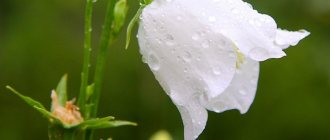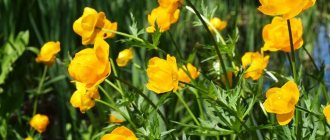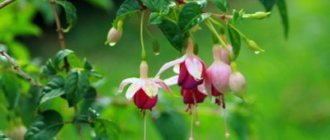The bulbous perennial plant Scilla is a member of the Asparagus family. However, some time ago this flower was classified as a member of the lily or hyacinth family. This plant is also called scylla. Often such a flower is mistaken for a snowdrop or woodleaf. This genus includes approximately 90 different plant species. Under natural conditions, they can be found in Africa, Asia and Europe, and they prefer to grow on plains and mountain meadows. The name of this flower comes from the Greek name for sea onion “skilla”, the fact is that it was previously a representative of this genus. This plant is highly resistant to frost and disease, and it is also very beautiful and can quickly adapt to any environmental conditions.
Description of the Scylla flower
Scylla is a perennial flower that is common in Africa, Europe and Asia. Belongs to the Liliaceae family. Frost-resistant varieties are used to decorate open flower beds, while other types are grown only indoors.
Blue Scylla species
Short description
Compared to other bulbous plants, scillas have a strong stem and slightly elongated internodes. After some time, a thin rhizome with a large number of bulbs is formed. Blue, lilac, pink inflorescences are more common, white flowers are much less common.
Features of the scilla
A bulbous plant such as scilla is a perennial. The bulbs are round or ovoid in shape, and their outer scales are purple, dark gray or brown. The basal linear leaf plates grow earlier or at the same time as the apical inflorescences, which have a brush shape and are located on leafless peduncles. This plant has one peculiarity: on rainy, cool days, its leaves are pressed to the surface of the soil, while when it is warm and sunny outside they are located almost vertically. The inflorescences contain single flowers. The fruit is a capsule containing black, irregularly ovoid seeds. Scilla is a primrose, as are the following plants: brandushka, white flower, dream grass (lumbago), goose onion, narcissus, pushkinia, chionodoxa, hazel grouse, saffron (crocus), adonis (adonis), eranthus (spring flower), hyacinth, muscari, snowdrop, primrose, dwarf iris and ranunculus. Most Scylla species bloom at the beginning of spring, but there are also species that bloom in autumn.
Types and varieties of scylla
Jacobinia flower - plant description, propagation and care
There are many varieties of snowdrops. Each scylla, whose shoots, flowers and leaves have different shapes and shades, is beautiful and unusual in its own way.
Varieties of snowdrop
Siberian scylla (Scilla sibirica)
Scylla sibirica got its name by mistake, because it does not grow in Siberian territory. It can be found in Europe, Crimea, and the Caucasus. This plant has blue flowers and leaves.
For your information! The uniqueness of this species lies in the fact that the flowers open at 10.00 and close at 16.00 in sunny weather, but in rainy weather they may not open at all.
Scilla Siberica has 3 subspecies:
- Caucasian - arrows 20-40 cm, dark blue and purple flowers;
- Armenian - bright blue flowers, arrows up to 16 cm, curved leaves;
- Siberian - 3-4 wide leaves, azure flowers, shoots up to 31 cm high.
No less common is Scylla Siberian Alba, which is characterized by exquisite snow-white flowers.
Note! In the West, the Spring Beauty flower with strong peduncles in green and purple shades is in demand among landscape designers. This variety contrasts well with Scylla Siberica Alba.
Scilla Hispanica
The plant is native to Europe. The bell-shaped type is the most attractive variety, which is distinguished by its small height, up to 30 cm, one stalk with blue, white and pink flowers. Flowering begins at the end of May. This type of scylla has several varieties - Rose Queen, Sky Blue, La Grandes, Rosabella, Blue Giant, etc. In the evening, the aroma of the inflorescences intensifies.
Scilla Bifolia
It is found near the Mediterranean Sea, in Crimea. This is the lowest variety with many flowers. The plant reaches a height of up to 15 cm, produces up to 3 peduncles with pink and white inflorescences. It has two leaves up to 20 cm long. The flowering period begins in mid-April.
Autumn Scilla (Scilla Autumnalis)
In the wild, the flower can be found in African and Asian countries. The plant produces up to 5 arrows up to 20 cm long with pale lilac or reddish-purple inflorescences. Narrow and linear leaves up to 26 cm long. Flowering starts in July-August.
Peruvian Scilla (Scilla Peruviana)
The plant grows in the western Mediterranean. Produces 2 to 3 arrows about 30 cm high with small bright blue inflorescences. The leaves are linear, up to 28 cm long and up to 1.6 cm wide. One plant has 5-8 leaves and up to 80 flowers.
Note! No less beautiful are other varieties of flowers, such as Scylla Mishchenko, Rosena, Campanulata, Litardiera, Bukhara.
Scylla flower, also known as scilla
Low-growing scilla is also called decorative onion
Scylla is a perennial plant of the Asparagus family. Botanists gave the name to the flower in honor of the Greek name for sea onion - “skilla”. One of the most famous species of this culture is the Siberian Scilla (Scilla siberica)
Brief description of what it looks like
Description of Scylla flower:
- low shrub with a height of 30 to 50 cm;
- lance-shaped dense leaf plates of a rich green hue, have parallel veins;
- lilac erect peduncles;
- the bulb is about 5 cm long;
- large bell-shaped flowers are located at the top of the peduncles;
- has 6 petals, a perianth and a stamen with a pistil.
The colors of Scilla flowers are presented in a varied palette.
Conditions for growing scylla at home
Medinilla - what kind of flower, description
In order for the blueberries to delight you with a well-groomed appearance and beautiful inflorescences, you must follow some rules of care.
Illumination and temperature conditions
Scylla loves ultraviolet rays and bright lighting. But in the summer season, you should still remove the pot with the flower away from the scorching sun to avoid burns. During the hot season, the optimal temperature is from 22 °C to 25 °C. From mid-autumn and winter, the indicators need to be reduced to 10-12 ° C, otherwise the flower will begin to stretch out greatly.
Planting white scylla outdoors
Watering rules and humidity
To prevent the roots and bulbs from rotting, it is necessary to water the plant moderately in the summer. In winter, the volume of water is reduced to avoid dropping leaves. It should be at room temperature and settled. Scylla is adapted to low humidity, so it does not require additional spraying.
Important! To prevent dust from accumulating, you should periodically wipe the leaves.
Fertilizing and soil quality
The soil must be breathable and loose. You can use a ready-made substrate for succulents or prepare it yourself by mixing leaf soil and humus (2:1). During the period of active growth, scillas need to be fertilized twice a month.
Important! In the fall, fertilizing is reduced, and in winter it is stopped altogether.
Planting scylla in open ground
Scilla can be planted outside in black soil near a border, flower bed, or alpine hill. Even a novice gardener can handle this.
Bathing flower - description of the plant, planting and care in the garden
Snowdrops are replanted even during flowering, but it is recommended to postpone this procedure until the foliage dies. This is the second half of June or 30 days before the flower stalks appear.
Note! All types of plants love light, although they sprout in sparse shade.
Planting a flower in a pot
Scylla reproduction
You can propagate the plant at home in different ways - seeds, bulbs.
- Seeds. They should be collected only when the boxes turn yellow and begin to crack. This process falls at the end of June. Immediately after collection, the seeds must be sown in the soil due to their low germination rate. After a few years, the scylla will bloom. It is recommended to leave the plant in one place without replanting for at least 5 years so that it forms more shoots and increases the number of inflorescences.
- Bulbs. During the growing season, the plant produces approximately 2 children. When all the leaves of the scilla have withered, you can plant the babies at a distance of 5 cm from each other and to a depth of 3 cm.
Note! Scylla sometimes reproduces by self-sowing. Therefore, you should not be surprised if the plant sprouts after winter in the wrong place.
Propagation of snowdrops independently
Scylla diseases and pests
Scillas with other bulbous crops can be subject to infection by various ailments, attacks by parasites and even rodents.
- Gray rot. It affects the foliage and the bulbous upper part, after which the plant becomes moldy and dies. You should immediately remove the affected stems, say goodbye to the diseased areas, and apply wood ash to the scars.
- Achellenchoides. It affects the bulbs, the above-ground part of the plant. The bush becomes covered with spots, the flower lags behind in development. The affected bulbs need to be dug up, and the good ones should be placed in a tray of hot water for processing.
- Bulb rot. The problem arises due to fungal infections - septoria, fusarium, sclerotinia. The disease progresses with high air humidity. Its characteristic manifestations are yellowish leaves and dirty red spots on the bulbs. It is impossible to save the flower.
- Rodents. Voles prefer to feast on snowdrops. To protect the flower, you need to make a groove around it with poison for rodents. You need to pour earth on top so as not to poison the birds.
- Meadow tick. The insect and its larvae tend to penetrate inside the bulb and gnaw out the pulp. Treatment of blueberries with acaricides will help destroy the pest.
Note! For preventive purposes, many gardeners spray plant bulbs with special insecticidal solutions before planting them in the soil.
Growing scylla such as Siberica, Rosea, bellflower or Pruan is quite simple with proper care. This is an unpretentious and beautiful plant that can be placed either in a pot in the room or outside under the window. Before purchasing or planting, it is worth studying the description of the variety and its degree of frost resistance.
Caring for scylla in the garden
Scilla is distinguished by its extreme unpretentiousness when compared with other spring flowers. In order for this flower to grow normally, it must be watered if necessary and then be sure to loosen the soil surface to a depth of 20–25 mm, while weeding. It is recommended to water in the morning, and you should try to ensure that the liquid does not get on the surface of the flowers, as this can greatly spoil their appearance. In order to significantly reduce the number of weedings and waterings, you should fill the area where Scylla grows with a layer of mulch (leaf humus).
Spring-blooming blueberries need to be fed with complex fertilizer (for example, Nitrophoska) at the beginning of the spring period, due to which the flowering will be much more magnificent. It is recommended to fertilize autumn-flowering species in the fall. It is best to add microelements such as iron, magnesium, calcium and copper to a complex mineral fertilizer.
It should be remembered that these plants reproduce well by self-sowing. If you do not want to regularly remove unnecessary scylla from the site, then you need to pick off the fading flowers, trying to do this before the seeds appear.
Transfer
For normal growth and development of this plant, it must be systematically replanted once every 3 years, this will also allow the bushes to maintain their high decorative value. Having dug up the bush, it is necessary to separate the children from the bulb, after which they are planted as soon as possible in order to avoid the appearance of rot on the bulbs. Experts advise transplanting to be done in the last days of September or the first days of October.
Scylla reproduction
For propagation, blueberries use seeds and daughter bulbs. How to propagate by bulbs is described in detail above. In order to grow such a flower from seeds, you first need to collect them. Around the last days of June, the seed pods should turn yellow and begin to crack. These boxes must be collected and the seeds poured out of them, which are immediately sown in open ground. Such seeds have a relatively low germination rate, and bushes grown from seeds will bloom only when they are 3 or 4 years old. The first planting of such plants is carried out no earlier than 5 years later, during which time they will grow a large number of children, and the number of flower stalks will also increase.
Diseases and pests
Like all small-bulbous plants, this flower is susceptible to infection with Achellenchoides, gray mold and bulb rot. The greatest danger of all pests to such a plant is the root meadow mite and mouse-like rodents.
Gray rot appears on the leaf blades and on the top of the bulb. Gray mold appears on the affected parts of the plant and they begin to rot. Then dense spots appear on the bulbs. As the disease develops, the bushes turn yellow and die. Affected specimens must be dug up and burned as soon as possible. If bulbs in storage are infected with gray rot, then the problem areas should be cut out and the wounds should be sprinkled with wood ash.
If a scilla is infected with Achellenchoides , then its aerial parts, as well as the bulbs, are affected. The scales on the bulbs turn brown and rot appears. So, if you make a cross-section of the bulb, you will notice ring rot. Necrotic spots appear on the surface of the affected bulb. Infected specimens show a loss of decorativeness and developmental delays. Infected bulbs are dug up and burned. For preventive purposes, healthy onions should be placed in a thermos with hot (43 degrees) water, where they should remain for 30 minutes.
Bulb rot occurs due to fungal infections, such as Fusarium, Sclerotinia or Septoria. The leaf blades of a recently infected bush begin to turn yellow, and then the infection penetrates into the bulbs, causing dirty red spots to appear on their surface. If you put infected bulbs in storage, they become very hard and die. This disease begins to develop very quickly at high humidity.
Mouse-like rodents (for example: house mice and voles) love to eat the bulbs of this plant, and in the spring they can eat its sprouts. To protect the scylla, it is necessary to make a protective groove around the area where it is grown. Baits with poison should be placed in this groove, and do not forget to sprinkle them with a little soil, because poisoned cereals can be pecked by birds, which will lead to their death.
The larvae and adults of the meadow root mite gnaw at the bottom of the bulbs and then make their way into their middle. There, pests begin to suck the juice from the internal scales of the bulb, which is why it begins to rot and dry out. To get rid of this harmful insect, you need to spray the affected bush with an insectoacaricide (for example: Agravertin, Actellik, Akarin, etc.). For prevention, before planting the bulbs in the soil, they should be treated with one of these products.











